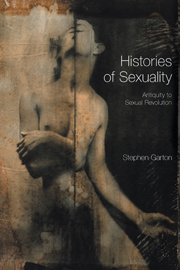Book contents
- Frontmatter
- Dedication
- Contents
- Preface
- 1 Writing Sexual History
- 2 Rule of the Phallus
- 3 Sexual Austerity
- 4 Christian Friendships
- 5 Making Heterosexuality
- 6 Victorianism
- 7 Dominance and Desire
- 8 Feminism and Friendship
- 9 Imagining Perversion
- 10 Normalizing Sexuality
- 11 Sexual Revolution
- Epilogue
- Endnotes
- Select Bibliography
- Index
10 - Normalizing Sexuality
- Frontmatter
- Dedication
- Contents
- Preface
- 1 Writing Sexual History
- 2 Rule of the Phallus
- 3 Sexual Austerity
- 4 Christian Friendships
- 5 Making Heterosexuality
- 6 Victorianism
- 7 Dominance and Desire
- 8 Feminism and Friendship
- 9 Imagining Perversion
- 10 Normalizing Sexuality
- 11 Sexual Revolution
- Epilogue
- Endnotes
- Select Bibliography
- Index
Summary
Historian Vern L. Bullough has argued that what differentiated early-twentieth-century sex research in America from that in Britain and Europe was its focus on heterosexual problems. Obviously there are exceptions to Bullough's generalization. American psychiatrists and criminologists, such as Frank Lydston, Adolf Meyer and William Healy, were at the forefront of investigations into degeneracy, delinquency and sexual psychopathology. There were also major American studies of ‘perversions’, notably the 1935 New York Sex Variants survey. Moreover, continuing media fascination with sexual notoriety, such as the transsexual Christine Jorgensen's famous announcement in 1952 that she had undergone sex change surgery, kept ‘deviancy’ in the news.
On the other side of Bullough's equation, British sexologists such as Marie Stopes, Havelock Ellis and Norman Haire, made significant contributions to research through their best-selling sexual advice books and articles, aimed largely at heterosexual couples. Moreover, European psychotherapists, such as Sigmund Freud, Carl Jung, Alfred Adler and Wilhelm Reich, may have begun by researching neurosis, anxiety and depression but moved from there to investigations of the structure of mental processes, collective psychological phenomena and the problems of general sexual misery.
Despite these exceptions Bullough has highlighted something important in twentieth-century sex research. Although some of the pioneering sexologists focused on the diagnosis, classification and treatment of perversions, others sought to examine ‘normal sexuality’. Some of this research was driven by the desire to chart the anatomy and physiology of human sexual response.
- Type
- Chapter
- Information
- Histories of SexualityAntiquity to Sexual Revolution, pp. 189 - 209Publisher: Acumen PublishingPrint publication year: 2004



